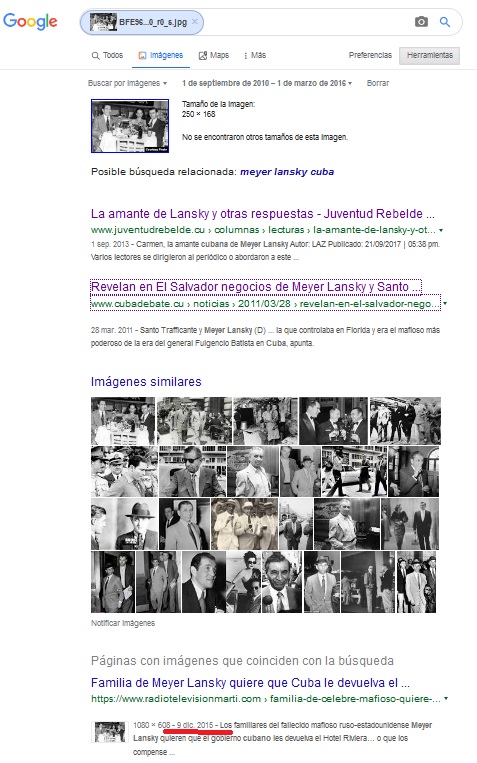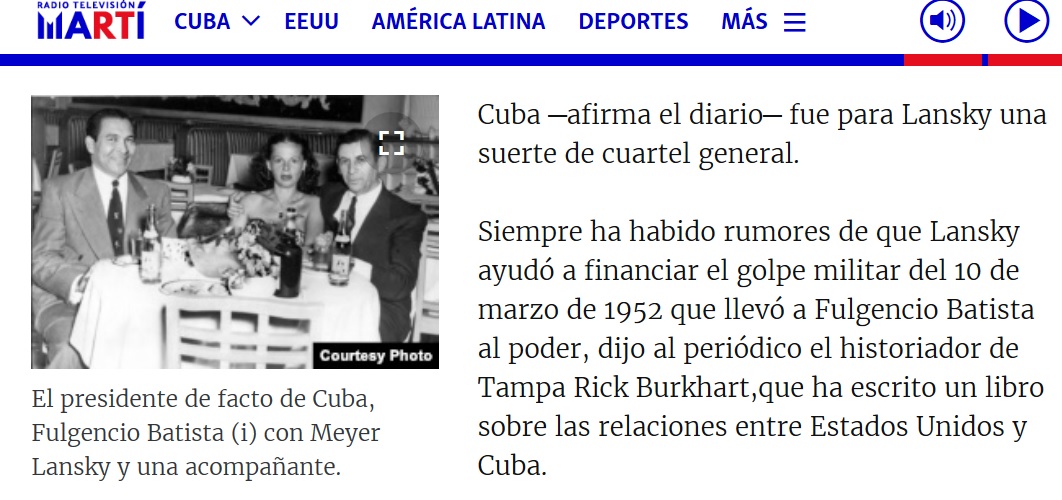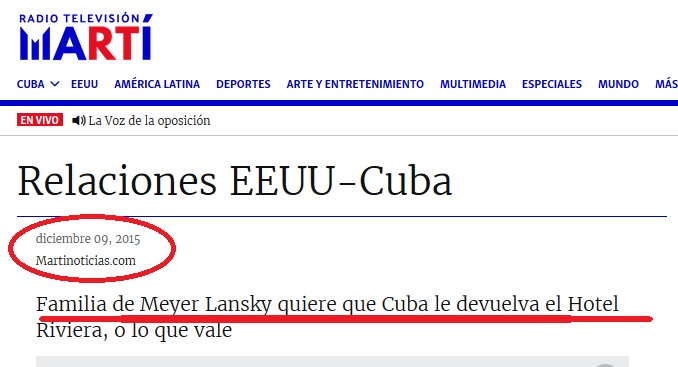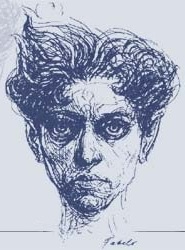La pasada semana una imagen del mafioso Meyer Lansky en La Habana junto al dictador Fulgencio Batista desató una polémica en las redes sociales, a partir de la existencia de otra foto en la que el lugar de Batista lo ocupa otra persona.
A pesar de que la mencionada imagen lleva años en internet, hay un detalle que hasta ahora ha pasado inadvertido: De ser falsa la imagen donde aparece Batista junto a Lansky, el primer falsificador sería el gobierno de los Estados Unidos, porque según el servicio de búsqueda inversa de imágenes de Google la primera vez que aparece en internet la “foto trucada” -como la han llamado voces de la propaganda anticubana pagada desde Washington- es el 9 de diciembre de 2015 en el sitio web de la gubernamental OficinadeTransmisioneshaciaCuba (OCB por sus siglas en inglés) “Radio Televisión Martí”

Búsqueda inversa en Google de la imagen donde aparecen Lansky y Batista que da como primera aparición el sitio de Radio Televisión Martí.

Foto de Batista y Meyer Lansky publicada en el sitio de Radio y Televisión Martí el 9 de diciembre de 2015.

Cabezal del artículo de Radio Televisión Martí con la foto de Batista y Meyer Lansky el 9 de diciembrede 2015.
Más allá de la falsedad o veracidad de la foto, que ojalá se esclarezca totalmente algún día, las relaciones de Batista con Lansky son notorias y de ello dan fe numerosas investigaciones. Si en algún lugar debe haber información precisa sobre el tema sería en los archivos del gobierno norteamericano, dueño del sitio web donde apareció por primera vez la foto en internet y empleador de propagandistas sin rostro pero con amo que es de esperar ahora cuestionen a Radio Televisión Martí, ¿o no?









Pingback: Sobre Batista y Meyer Lansky… ¿quién lanzó la foto? | argencuba
De ser falsa la imagen, me pregunto cuál sería entonces el objetivo del falsificador en mostrar a un Batista solo, sin los personeros de su séquito que lo acompañaban a todas partes, compartiendo una mesa con Lansky y su esposa en un club-restaurant o centro nocturno.
¿Dar una imagen errónea sobre la relación entre el juego, la mafia y el batistato? No he hallado en la red ninguna otra fotografía donde aparezcan juntos el dictador y Lansky
Iroel, es muy revelador el dato que la primera vez que aparece la imagen en internet es “el 9 de diciembre de 2015 en el sitio web de la gubernamental Oficina de Transmisiones hacia Cuba (OCB por sus siglas en inglés) “Radio Televisión Martí”. La imagen falsificada que diseminan por la red los propagandistas de RTM y otros aparatos está estrechamente vinculado con las manipulaciones que vienen realizando estos elementos a partir del 2016 con el fin de obtener una indemnización a favor de los herederos de Lansky por los bienes inmuebles que le fueron expropiadas legítimamente conforme a lo que disponen nuestras leyes. El centro del reclamo es el hotel Riviera. El objetivo es sembrar la figura de un Lansky, casado, amigable, afable con tratos y relaciones directas con el dictador y sus ministros, los cuales aprueban, garantizan y amparan sus inversiones. Pretenden borrar así la ilicitud, el delito, la corrupción y la extorsión asociadas a las actividades de Lansky en nuestro territorio.
Comparto el siguiente artículo que ahonda en este asunto:
Meyer Lansky’s Heirs Want Money from Cuba
https://consortiumnews.com/2016/06/25/meyer-lanskys-heirs-want-money-from-cuba/
A curious twist in the renewed U.S.-Cuban relations is the claim by Mafia financier Meyer Lansky’s heirs for damages from the loss of Lansky’s Havana casinos, which Fidel Castro nationalized after the revolution in 1959, writes Jack Colhoun.
By Jack Colhoun
The heirs of Meyer Lansky, the impresario of the North American Mafia gambling colony in Cuba, a reign that lasted from 1933 to 1958, are betting on a big payback from the negotiations between the United States and Cuba to normalize relations between the two countries.
Compensation claims by U.S. citizens or businesses for properties nationalized by the Cuban revolution are among the issues under discussion. Lansky’s daughter Sandi, her son Gary Rapoport, and her brother Paul have filed a compensation claim against Cuba for the Riviera Hotel and Casino with the U.S. Foreign Claims Settlement Commission.
The Cuban revolution confiscated the Riviera and other Mafia-owned properties after it toppled the gangster-linked regime of General Fulgencio Batista in 1959.
“It was through my grandfather’s hard work that the hotel was built,” Rapoport told the U. K. Daily Mail Online on Dec. 23, 2015. “We are his natural relations . . . . By right, it should be our property.” He said the Riviera is valued at $70 million. The Tampa Bay Tribune, Reuters, and Haaretz have also covered the story. (Lansky died in 1983 at the age of 80 from lung cancer, living his final years quietly in Miami Beach.)
The Riviera, which overlooks the Straits of Florida, was the crown jewel of Lansky’s casinos, hotels and nightclubs in Havana. When the Riviera opened in December 1957, it was the largest Mafia-owned hotel-casino outside Las Vegas. The hotel’s 440 double rooms were booked solid for the winter season of 1957-1958.
However, the narrative that the success of the Riviera was the product of Meyer Lansky’s “hard work” is undercut by Lansky’s own assessment of his arrangement with Batista. Lansky talked candidly about his years in Cuba with Israeli national security writers Dennis Eisenberg, Uri Dan, and Eli Landau for their admiring biography Meyer Lansky: Mogul of the Mob (Paddington Press, 1979). (Lansky lived in Israel in 1970-1971 to avoid tax evasion charges in the United States.)
Lansky pitched his plan to Batista to open Mafia owned casinos and nightclubs in Cuba in 1933. Lansky promised to make Batista, who had just come to power in a coup d’etat, a partner. Batista and his inner circle would get regular payments from the Mafia gamblers. In return, the gangsters would be allowed to operate without interference from Cuban authorities. With a handshake and an abrazo, Lansky and Batista laid the foundations of the Cuban gangster state.
“Working on the well-known principle that it’s better to use other people’s money than your own, Lansky persuaded Batista to have the Cuban government help finance the venture,” Eisenberg, Dan, and Landau wrote. “The [Cuban] government agreed to back every dollar invested on the island by foreigners with a dollar of its own and to give every hotel that cost more than one million dollars the precious prize of a gambling license . . . and the casino hotels would not have to pay Cuban taxes.”
Lansky’s Crown Jewel
The Riviera was one of four new hotels with casinos, which opened in Havana between 1955 and 1958. Cuban development banks subsidized 50 percent of Lansky’s $14 million Riviera project; Lansky-linked investors provided the rest. Senator Eduardo Suarez Rivas, brother of Batista’s Minister of Labor Jose Suarez Rivas, was secretary of the Compania de Hotels La Riviera de Cuba, which operated the Riviera.
The Mafia gambling colony was the cornerstone of the Cuban gangster state. The gangsters’ graft bound Batista, his inner circle, senior security officers, and the Mafia together in the defense of one of the most repressive regimes in Latin America. As a CIA report put it, “In return for the loyalty they gave him, Batista always backed his security services. In times of crisis, he often suspended civil guarantees . . . and gave the services a free hand.”
In 1958, Fidel Castro’s July 26th Movement denounced the Mafia in radio broadcasts from the guerrilla group’s redoubt in the Sierra Maestra, accusing the Mafia of turning Havana into a center of commercialized vice – gambling, prostitution, and drugs. The days of the North American gangsters in Cuba were numbered when Batista fled into exile on Jan. 1, 1959. When Castro arrived in Havana on Jan. 8, he vowed to “clean out all the gamblers.”
The Riviera and other gangster-owned properties were nationalized, and the Mafia gamblers returned to the United States. To regain control of its casinos, hotels and nightclubs in post-Castro Cuba, the Mafia waged a covert war on the Cuban revolution. The gangsters regrouped with their Cuban political allies, now in exile in the United States. The Mafia subsidized Cuban exile leaders and supplied arms to Cuban exile commando groups for attacks on Cuban targets from speedy boats and small aircraft.
The gangsters also plotted with the CIA to assassinate Fidel Castro.In 1959, Lansky volunteered to arrange the assassination of Castro in a meeting with the CIA, according to Doc Stacher, a life-long Lansky associate.
“He [Lansky] indicated to the CIA that some of his people who were still on the island, or those who were just going back, might assassinate Castro,” Stacher told his Israeli biographers. “Meyer Lansky thought that if Castro would be eliminated there was a good chance for Batista to make a comeback. . . . He told them [CIA officers] he was quite prepared to finance the operation himself.”
From 1960 to 1963, the CIA and the Mafia plotted covertly to assassinate Castro. So, to portray Lansky as an aggrieved victim of Cuba is to stand history on its head. There should be no compensation for the heirs of the former Mafia gamblers in Cuba.
Jack Colhoun is an historian of the Cold War (University of Wisconsin, Madison, BA, 1968; York University, Toronto, PhD, 1976), an investigative reporter, and professional archival researcher. His work has appeared in the Washington Post, Toronto Star, Salon, History News Network, The Nation, The Progressive, In These Times, the former (New York) Guardian newsweekly, and former Covert Action Quarterly. He is the author of Gangsterismo: The United States, Cuba, and the Mafia, 1933-1966 (New York: OR Books, 2013). [This article previously appeared at http://historynewsnetwork.org/article/162856
Estimado Iroel,
Si a cada petición que el mismo pueblo de Cuba (me considero parte del pueblo cubano) le hace a usted, en favor de que se asegure que sus escritos son veraces y no caer en fakenews le va a llamar usted ANTICUBANOS pagados desde Washington, entonces nada en realidad hemos aprendido.
No todo el que hacer llegar su critica o parecer al trabajo que usted desempeña es mercenario ni obedece a una ideología anticubana.
Basta ya de esgrimir esas archiconocidas vacías defensas.
Por otro lado, le repito, desconozco el momento en que la prensa y el movimiento intelectual cubano comenzaron a darle crédito a emisiones de Radio y Tele Martí.
Si pudo mas la emoción de una noticia vinculante que el tiempo necesario en evaluarla e identificarla como verdadera, entonces no es menos valiente que reconocer el error y punto.
Lo demás es justificación y quedar mal ante los lectores de su trabajo.
Una postura honesta que respeto, a diferencia de quienes ocultan su rostro para intrigar y mentir:”Gracias. Confirmo que tiene Ud. razón. En el sitio de Radio y TV Martí aparece la foto ya trucada; no puede atribuírsele a su artículo de hace unas semanas. No concido con su postura, pero toda discusión debe tenerse, ante todo, sobre la base de la honestidad” https://twitter.com/reinaldomeister/status/1176216807901978626
Iroel, a modo de sugerencia, creo que sería mejor que cuando publique un artículo con alguna foto simplemente añada los créditos de la foto, es decir de donde la tomó. Saludos
Gracias a Iroel por su firmeza, honestidad y coherencia que hasta pesonas como Reinaldo que se define como no coincidente con él tienen que reconocer.
Lo que ha demostrado este episodio es el alcance e importancia de este blog incluso para los enemigos de la Revolución, que pasaron por alto la foto cuando la publicó Radio Martí, Cubadebate y otros espacios y emprendieron un linchamiento oportunista cuando se puso aquí.
Pero Iroel subió la parada y los puso en ridículo con este artículo, que aprendan.
Pingback: Sobre Batista y Meyer Lansky… ¿quién lanzó la foto? | HAVANA INSIDE